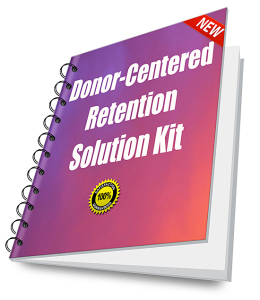Do you know how you may be breaking your donor’s heart? Keep it up, and they’ll break yours.
This is important.
It’s about a new report that may change how you do fundraising.
It should.
Let me explain.
Unless you’ve been asleep at the wheel, by now you should know that most nonprofits have been hemorrhaging donors.
By tending to focus more on expensive, staff-intensive acquisition strategies like direct mail and special events, charities are bringing in one-time donors who never give to them again.
This is why I’ve chosen to focus on mastering donor retention as one of my “Dive the Five” strategies all nonprofits must excel at in 2016 — and beyond.
The latest Fundraising Effectiveness Project Report revealed that an astounding 81% of first-time donors lapse. [BTW: This isn’t the report that’s going to change your modus operandi; it’s merely the rationale for the release of the report that will. Keep reading.] Of repeat donors, 37% lapse. For every 100 new donors acquired, on average nonprofits lost 96 existing donors.
This is the proverbial three steps forward, two steps back – only worse!
This burn and churn strategy is killing nonprofits — and burning out the folks who work in them.
The end-of-the-year numbers tell the story. Overall, an average nonprofit keeps just 46% (4.6 of 10) of donors vs. 94% (9.4 of 10) of customers for businesses. Why the disparity?
It’s common knowledge in the for-profit world that it costs much more to secure a new customer than to retain an old one. So businesses, because they know it’s cost-effective, focus on customer service. Otherwise, they’d run out of potential customers pretty soon. They’d go out of business.
Somehow too many nonprofits haven’t fully grasped the same holds true with donors and nonprofit businesses. Your supporter world really isn’t infinite (even in the digital age). If you keep ticking folks off after they’ve given to you, you’re not likely to keep them for long. Or their friends, family or colleagues either. Word gets around.
You can’t keep losing ground at the rate at which the average nonprofit today is losing it.
A fundraising program that focuses on one-time transactions won’t get you very far. You need to build a business model that moves your organization steadily forward – based on your reputation for effectiveness and service.
To gain ground requires you to (1) actively show donors the impact they’ve made through their philanthropy, and (2) remind them they are heroes for having come to the rescue.
There’s tons of competition for donor dollars today. If you don’t do something intentional to make donors happy and assure their loyalty, donors are not going to stick with you.
Which brings me back to my purpose for writing to you today.
I am convinced that if you do just two things you will raise a lot more money from current donors and lose a lot fewer of them.
Specifically, you will:
- Create more passionate donors, and
- Keep them loyal
The two things are simple to understand.
Yet, in practice, not so simple.
They boil down to just three words: Donor. Centered. Relationships.
Thing One: Donor-centered fundraising.
Thing Two: Relationship fundraising.
Let’s pause for a minute for definitions.
Here’s Penelope Burk’s definition of donor-centered fundraising:
“[Donor-centered fundraising] is an approach to raising money that inspires donors to remain loyal longer and give more generously. It is easy to understand; it focuses on the things that make fundraising profitable; and it comes from donors themselves.”
Here’s Ken Burnett’s definition of relationship fundraising in the seminal book of the same name:
“[Relationship Fundraising’s] overriding consideration is to care for and develop that bond [between supporter and nonprofit] and to do nothing that might damage or jeopardise it. Every activity is therefore geared toward making sure donors know they are important, valued and considered, which has the effect of maximising funds per donor in the long term.”
 Thing One: Donor-Centered Fundraising
Thing One: Donor-Centered Fundraising
In my career, I had one “light bulb” moment that completely changed how I did fundraising.
It was meeting Penelope Burk, learning about her comprehensive research into the things donors most wanted from nonprofits and reading her pioneering Donor-Centered Fundraising (my copy is completely dog-eared). No one has expounded more eloquently on the subject of donor-centered fundraising than Penelope Burk.
We toss this phrase around lightly today, but 20 years ago it was the first comprehensive look at the way donors think and feel. And it was wildly divergent from the way nonprofits thought donors felt.
Nonprofits then were scrambling to make donors happy with Gala events, donor recognition walls, hand-engraved plates, fancy newsletters, annual reports and so forth. Many nonprofits, sadly, are still trudging down this path. And while there’s nothing wrong with events and donor communications and the occasional token gift, it’s not the place to begin building your connection to your donor.
When donors make their first gift, the main thing they want to know is whether they can trust you.
Trust is at the heart of every lasting relationship.
And it turns out, based on Penelope’s research, that donors really want only three simple things – all of which boil down to you showing them they can trust you. Because when donors give they have a bit of anxiety. Did they make a good decision? Will you get the money? Will you use it wisely? Will it make any difference? Might there have been a better way to spend their hard-earned dollars.
Your job, right off the bat, is to assuage your donors’ anxiety.
They want to know you received their gift, you put it to work the way they thought you would, you truly appreciated their philanthropy and the end result is something of which they can be proud. Donors want a:
- Prompt thank you,
- Personal thank you, and a
- Report on impact before you ask again.
That’s it!
It shouldn’t be that difficult.
Research has confirmed the importance of saying thank you in order to satisfy supporters, engender feelings of trust and kick-start their ongoing, loyal relationship with you. I found a great article on the Donorbox blog discussing nine different ways to build strong donor relationships. Read and heed them all, and don’t be at all surprised one of the key strategies is building trust.
Nothing is more predictive of loyalty than trust and customer satisfaction – and it’s important you provide this satisfaction consistently over time. So don’t just thank donors once. Do it multiple times, in multiple ways, in multiple venues.
Communicate. Communicate. Communicate.
Research shows the primary reasons why donors leave are closely connected to failed communication strategies. Ongoing communication is the foundation of REAL friendship and the key to fundraising sustainability.
Which brings us to the new report, and what to do over time to stop losing donors and build growing loyalty.
 Thing Two: Relationship Fundraising
Thing Two: Relationship Fundraising
I hope if you read Rogare’s Relationship Fundraising: Where Do We Go From Here you will have a “light bulb” moment.
It’s about the latest fundraising research to come out of Rogare. Rogare (Latin for ‘to ask’) is the Centre for Sustainable Philanthropy’s fundraising think tank and the home of Critical Fundraising – the discipline of critically evaluating what fundraisers know, or think they know, about their profession.
Last year I had the honor to serve as part of an international Advisory Panel to Rogare, in a project jointly funded by US donor management software company Bloomerang and American fundraising agency Pursuant. We were charged with embarking upon an almost year-long, international effort to evaluate the status of relationship fundraising by incorporating ideas from psychology and relationship marketing science, and making recommendations for moving forward to stop the leaking bucket syndrome and drive greater donor commitment. This was the first major study on relationship fundraising conducted in twenty-five years. Other advisors included such well-known nonprofit experts as Ken Burnett, Sean Triner, Craig Linton, Tom Ahern, Simone Joyaux, Jay Love, Gail Perry, Marc Pitman, Kivi Leroux Miller, Kent Stroman, and more.
The four-volume report – Relationship Fundraising: Where Do We Go From Here – is now available to download.
Volume 1 – Examines the evidence for relationship marketing in the commercial sector and assesses whether, and under what circumstances, this can be transferred to fundraising, or if there are times when transactional approaches are appropriate.
Volume 2 – Explores how fundraisers can utilize and adapt current and emerging theories in social psychology to build better relationships that help meet their donors’ needs.
Volume 3 – Leading relationship fundraising practitioners from around the world describe current trends in relationship fundraising and outline some of the key challenges they think it faces, and what the profession needs to do to meet those challenges.
Volume 4 – Summarizes the findings from volumes 1-3 and recommends future directions that relationship fundraising could take.
There’s a lot of food for thought here, and it’s best to read it for yourself. I hope your copy will become as dog-eared as my Donor-Centered Fundraising book from Penelope Burk became. I can assure you that my copy of this report is already becoming similarly filled with underlines, annotations and post-it notes.
Here are two bottom-line takeaways for you:
Before you enact any fundraising or marketing strategy, always ask the donor-centric question “What’s in it for me?”
If the donor can’t see why they should say “yes” – be it to accepting an invitation to coffee, coming on a tour, opening an email, sharing a link on social media, or making another gift – then you’re not going to get very far down the road with them.
Get inside your donor’s head, and think consciously about what may connect with them. What may be relevant and meaningful to them? What may reward them for their incredibly important support? What may make them feel special? What may make them feel like they belong? What may make them feel they’re part of something important – something larger than themselves?
If you can stand in your donor’s shoes, and show them you know them, you can’t help but improve your results.
Before you ask for another gift, always be sure to send stories and reports that clearly demonstrate the impact of your donor’s philanthropy.
Donors lament that reporting, if it happens at all, rarely includes accountability for how their contributions were spent and what was achieved. However, when this information is provided to donors, they are ready to give again almost immediately.
If you will comply with donor wishes, and meet their straight-forward requirements for donor acknowledgements and donor-centered communications, they are more than willing to stay loyal and give even more generously in the future.
Is there anything you’ll do differently moving forward? Please share in the comments below.
Get Your Donor Retention Bible!
Your Step-by-Step Guide to Donor Retention
Get my Donor Retention and Gratitude Playbook with 6 separate companion guides (purchase individually or at a bundle bargain discount). Taken together, they include everything you need to raise more money — by keeping more current donors and increasing their average gift! It’s filled with hands-on, practical information garnered from my 30+ years working in the nonprofit trenches. The Attitude of Gratitude Donor Guide alone is 98 full pages, with lots of ready-to-use samples and templates. You’ll save almost a third if you buy them all together. Grab your bargain bundle here. I promise if you read these E-Guides, and put the recommended strategies into action, you’ll keep more donors and raise more dollars. If not, I’ll happily give your money back.
-
Pingback: Top 10 Ways to Upgrade Nonprofit Donors







